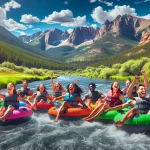Paint Mines Interpretive Park, spanning over 750 acres, is a hidden gem in the eastern plains of Colorado. This unique park offers visitors a chance to explore colorful geological formations, diverse wildlife, and a rich Native American history dating back thousands of years. The colorful clay, caused by oxidized iron compounds, was historically used by American Indians to make paint and is now considered one of the most beautiful marvels in the United States. With its easy to moderate hiking trails and stunning landscapes, Paint Mines Interpretive Park is a must-visit destination for outdoor enthusiasts and history buffs alike.
In This Article
TL;DR
- Paint Mines Interpretive Park’s 750 acres feature a variety of vibrant rock formations, grasslands, and wetlands.
- The park offers approximately 4 miles of trails suitable for hikers of all skill levels, with minimal elevation gain.
- Evidence of human activity at the park dates back over 9,000 years, making it a significant archaeological site.
Exploring the Geological Wonders
The Paint Mines Interpretive Park in El Paso County is known for its distinctive geological formations, including hoodoos and spires. These colorful formations are the result of erosion over millions of years, exposing layers of colored clay and sandstone. The iron oxides present in the clay are responsible for the vibrant red, yellow, and purple hues that give the park its name.
The colorful clays found in the park have historical significance as well. Native Americans once used these natural pigments for pottery, paint, and other purposes. As you explore the park, you’ll come across interpretive signs that provide insights into the geological processes and the importance of these clays to the area’s indigenous people.
Hiking Trails and Outdoor Activities
Paint Mines Interpretive Park offers a trail network that allows visitors to explore the park’s unique features. The main trail, Paint Mines Trail, is a 4-mile loop that winds through the park’s most scenic areas. The trail is well-maintained and relatively flat, making it suitable for hikers of all skill levels. Along the way, you’ll encounter interpretive signs that offer information about the park’s geology, history, and wildlife.
In addition to hiking, the park provides excellent opportunities for wildlife watching. Keep an eye out for birds such as hawks, falcons, and the lark bunting, which is Colorado’s state bird. You may also spot mammals like mule deer, pronghorns, and coyotes. Remember to maintain a safe distance and avoid disturbing the animals in their natural habitat.
The park’s stunning landscapes also make it a popular destination for photography enthusiasts. The best times to capture the vibrant colors of the rock formations are during the early morning or late afternoon when the sun is lower in the sky. Be sure to stay on designated trails and respect the fragile environment while taking photos.
Preserving the Park’s Integrity
Visitors must adhere to certain rules and regulations to protect the delicate ecosystem and archaeological sites within El Paso County’s Paint Mines Interpretive Park. These guidelines include:
- Staying on designated trails at all times
- Refraining from climbing or scrambling on the paint mine formations
- Leaving plants, rocks, minerals, and artifacts undisturbed
- Keeping pets, horses, and bicycles out of the park
By following the Leave No Trace principles, visitors can help minimize their impact on the environment and ensure that future generations can enjoy the park’s beauty.
Educational Opportunities
Paint Mines Interpretive Park offers various educational opportunities for visitors to learn about the area’s geology, history, and ecology. Interpretive signs placed along the trails provide valuable information about the park’s features and the Native American people who once inhabited the region.
Guided tours led by knowledgeable park staff or volunteers are occasionally available, offering a more in-depth understanding of the park’s significance. Check with the park’s visitor center or website for information on upcoming guided tours and educational programs.
Planning Your Visit
The best times to visit Paint Mines Interpretive Park are during the spring and fall when temperatures are mild, and the weather is generally pleasant. Summer visits can be hot, with temperatures often reaching the 90s (Fahrenheit), so be sure to bring plenty of water, sunscreen, and a hat for protection.
The park is open daily from dawn to dusk and has no entrance fee. Parking is available at the main trailhead, which is accessible via a well-maintained gravel road. The park has limited facilities, including a restroom in the parking lot, but no drinking water is available, so be sure to bring your own.
FAQ
What should I bring for a day hike at Paint Mines Interpretive Park?
Essential items to bring include water, snacks, sunscreen, a hat, and sturdy hiking shoes. Dress in layers to accommodate changes in weather and temperature throughout the day.
Are dogs allowed in the park?
No, dogs and other pets are not permitted in Paint Mines Interpretive Park to protect the fragile ecosystem and prevent disturbance to wildlife.
Can I collect rocks or minerals from the park?
All rocks, minerals, and artifacts must remain in the park. Collecting or disturbing these items is strictly prohibited to preserve the park’s natural and historical resources.
Is there cell phone reception in the park?
Cell phone reception may be limited or unavailable in some areas of the park due to its remote location. It’s a good idea to download or print any necessary maps or information before your visit.
Are there guided tours available?
Guided tours may be available on a limited basis, depending on staff availability and seasonal demand. Check with the park’s visitor center or website for information on upcoming guided tours or educational programs.






